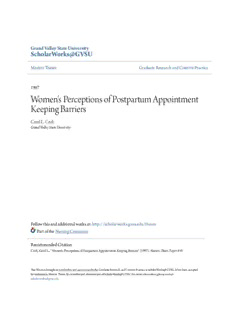Table Of ContentGGrraanndd VVaalllleeyy SSttaattee UUnniivveerrssiittyy
SScchhoollaarrWWoorrkkss@@GGVVSSUU
Masters Theses Graduate Research and Creative Practice
1997
WWoommeenn''ss PPeerrcceeppttiioonnss ooff PPoossttppaarrttuumm AAppppooiinnttmmeenntt KKeeeeppiinngg
BBaarrrriieerrss
Carol L. Czuk
Grand Valley State University
Follow this and additional works at: https://scholarworks.gvsu.edu/theses
Part of the Nursing Commons
SScchhoollaarrWWoorrkkss CCiittaattiioonn
Czuk, Carol L., "Women's Perceptions of Postpartum Appointment Keeping Barriers" (1997). Masters
Theses. 419.
https://scholarworks.gvsu.edu/theses/419
This Thesis is brought to you for free and open access by the Graduate Research and Creative Practice at
ScholarWorks@GVSU. It has been accepted for inclusion in Masters Theses by an authorized administrator of
ScholarWorks@GVSU. For more information, please contact [email protected].
WOMEN'S PERCEPTIONS OF POSTPARTUM
APPOINTMENT KEEPING BARRIERS
By
Carol L. Czuk
A THESIS
Submitted to
Grand Valley State University
in partial fulfillment of the requirements for the
degree of
MASTER OF SCIENCE IN NURSING
Kirkhof School of Nursing
1997
Thesis Committee Members:
Patricia W. Underwood, Ph D., R.N.
Katherine K Kim, PhJD., RN
Frances McCrea, PhD
ABSTRACT
WOMEN’S PERCEPTIONS OF POSTPARTUM APPOINTMENT KEEPING BARRIERS
By
Carol L. Czuk
An exploratory, descriptive design was used to examine women's perceptions of barriers that
inhibited them from keeping their postpartum appointments. The Health Belief Model (HBM) was
used as a theoretical framework, with special attention to the barriers dimension. A three-part
surv^ consisting of basic demographic questions, a five point response scale for assessment of
perceived barriers, and open-ended questions were used for data collection. A convenience
sample of IS women in a rural southwestern Michigan community who had not kept their
postpartum appointment by the sixth week after delivery were included in the study. Data were
collected by a structured telephone interview method. The results of the study reveal that a low
value attached to postpartum care and logistical (access to care) barriers posed the greatest threat
to obtaining postpartum care in the group studied.
Dedication
Dedicated in remembrance of my mother, B Lawain Gok^ [1934-1996], who stressed
upon me at an early age the importance of an education.
Acknowledgments
I would like to personally extend my sincere appreciation to Patricia W. Underwood,
Ph D., R.N., the chairperson of my thesis committee. Her knowledge, insight, expertise,
and support have been instrumental in my continued education efiforts.
Special thanks to Katherine K. Kim, Ph_D., R.N. and Frances McCrea, Ph. D. for their
counsel, time, and interest in this research endeavor.
I would also like to thank Linda Scott, M.S.N., R.N. For her patience and guidance with
the statistical portion of my thesis.
Last, but not least, I would like to thank Steven M. Czuk for his unfailing support and
encouragement in my continued education.
Table of Contents
List of Tables.....................................................................................................................vii
List of Figures............................................................................................................... viii
List of Appendices........................................................................................................... be
CHAPTER
1. INTRODUCTION.....................................................................................................1
2. THEORETICAL FRAMEWORK AND LITERATURE REVIEW ......................4
Theoretical Framework...............................................................................4
Literature Review......................................................................................II
Research Question....................................................................................20
Definition of Terms ..................................................................................21
3. METHODOLOGY ................................................................................................22
Research Design........................................................................................22
Sample.......................................................................................................22
Instrument .................................................................................................23
Procedure...................................................................................................25
Human Subjects Protection.......................................................................26
4. DATA ANALYSIS...............................................................................................28
Sample Characteristics.............................................................................28
Research Question....................................................................................29
Other Findings of Interest.........................................................................31
Summary...................................................................................................32
5. DISCUSSION AND IMPLICATIONS ................................................................33
Relationship to Previous Research ...........................................................33
Relationship to Theoretical Framework ..................................................36
Limitations and Recommendations...........................................................37
Implications for Nursing Practice.............................................................39
Sununary..................................................................................................41
6. APPENDICES.......................................................................................................43
7. REFERENCES .....................................................................................................58
VI
List of Tables
Tables Page
I. Top Six Highest Rated Perceived Barriers..........................................................31
vu
List of Figures
Figures Page
1. The Health Belief Model .......................................................................................6
vui
List of Appendices
Appendix Page
A. Permission to Adapt Instrument.............................................................................43
B. Postpartum Care Client Surv^ .............................................................................44
C Script for Introduction to Postpartum Care Client Survey.....................................51
D. Script for Telephone Interview...............................................................................52
E. Informed Consent ..................................................................................................53
F. Permission from Human Research Committee of Grand Valley State
University .............................................................................................................54
G. Perceived Barriers Rating Summary......................................................................55
IX
Description:surv^ consisting of basic demographic questions, a five point response scale for assessment of The results of the study reveal that a low .. A history of previous successes and failures may impact a person"s .. that women's beliefs, knowledge, attitudes, and feelings influence their use of prenata

